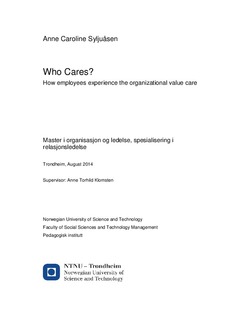| dc.contributor.advisor | Klomsten, Anne Torhild | nb_NO |
| dc.contributor.author | Syljuåsen, Anne Caroline | nb_NO |
| dc.date.accessioned | 2014-12-19T14:40:18Z | |
| dc.date.available | 2014-12-19T14:40:18Z | |
| dc.date.created | 2014-11-10 | nb_NO |
| dc.date.issued | 2014 | nb_NO |
| dc.identifier | 762140 | nb_NO |
| dc.identifier.uri | http://hdl.handle.net/11250/270162 | |
| dc.description.abstract | The study attempts to answer the question: How do employees experience the organizational value care? The organization Nortec introduced care as one of its organizational values. The application of care in business may counteract and combat possible undesirable side effects of increased organizational efficiency. Some reported side effects experienced by employees are colder and more demanding working environment (Maslach & Leiter, 1997). Therefore I was intrigued to study how care was experienced by employees within an organization that had already put care on the agenda and applied it as an organizational value. Care is an ambitious value and may not be straight forward to implement into the workday’s interactions.
A total of four employees, two subordinates and two leaders, were interviewed with regard to how they experienced care at work. The qualitative semi-structured interviews were audio recorded, transcribed and analyzed. The analysis returned a total of four categories that were labeled as: Perception of care, Experience of care, Trust and Attentiveness. All four categories contributed into the understanding of the experience of care for each of the informants. The perception would determine the informant’s expectation of care, according to which the informants rated their experience. Finally the last two categories, trust and attentiveness were considered basic constituents for applied care to be recognized.
In the theory section I proposed a model of care composed of various dimensions representing my pictorial understanding of care. However, the empirical findings returned with a revised model where the main constituents of care were trust and attentiveness. All informants revealed these dimensions as significant in the care experience. Also, the findings indicated a difference in experienced care between the subordinates and the leaders. Both subordinates expressed low level care in terms of trust and attentiveness from leader, whereas the leaders did not convey a similar discontent.
The study reveals essential information about how care is experienced for the participants and consequently how care is recognized inside the specified relations. The study provides important information towards possible future studies to identify whether the same trends are identifiable through a quantitative study in the organization. Finally all information from this study and future studies would add significant value into the management’s strategic leadership development to increase understanding and employee contentment and to root the care value within the company’s DNA. | nb_NO |
| dc.language | nor | nb_NO |
| dc.publisher | Norges teknisk-naturvitenskapelige universitet, Fakultet for samfunnsvitenskap og teknologiledelse, Pedagogisk institutt | nb_NO |
| dc.title | Who Cares?: How employees experience the organizational value care | nb_NO |
| dc.type | Master thesis | nb_NO |
| dc.source.pagenumber | 96 | nb_NO |
| dc.contributor.department | Norges teknisk-naturvitenskapelige universitet, Fakultet for samfunnsvitenskap og teknologiledelse, Pedagogisk institutt | nb_NO |
